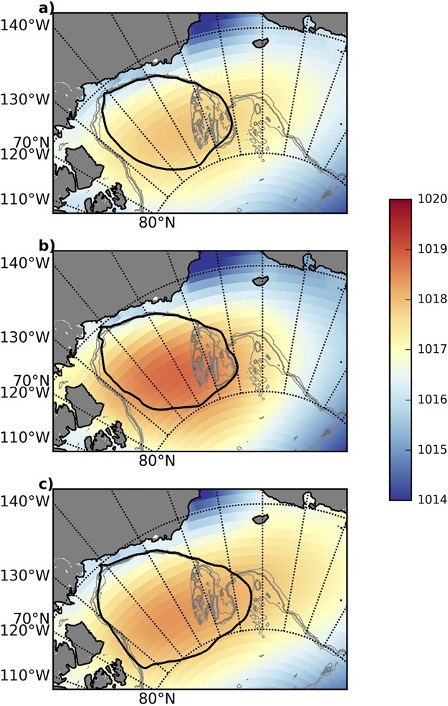
ARKTALAS Hoavva, funded by the European Space Agency, addresses four major scientific challenges for the Arctic. The Beaufort Gyre in the Arctic Ocean has spun up over the last couple of decades. In this study a high-resolution eddy resolving model has been used to study accumulations of fresh water in the gyre and its role in the ocean circulation in the Arctic Ocean.
The Beaufort Gyre in the Arctic Ocean is an anticyclonic upper-ocean circulation feature that is the largest reservoir of fresh- water in the Arctic. The gyre has spun up over the past two decades in response to changes of the wind forcing and sea ice conditions, accumulating a significant amount of freshwater. This will have an impact on the circulation in the Arctic Ocean as well as the variability of freshwater export from the Arctic, which again has the potential to influence the North Atlantic circulation and climate affecting the deep-water formation and global conveyor belt circulation. In this study a simulation performed with a high-resolution, eddy-resolving model is analyzed to provide a detailed description of the total and eddy kinetic energy and their response to this gyre spinup. The results of the model simulation (see Figure) describe the spatiotemporal evolutions of the total and eddy kinetic energy in the Canada Basin. In contrast to previous results, we find that the gyre is able to spin up and sustain a higher level of mean kinetic energy that is generally not accompanied by higher levels of eddy kinetic energy. On average, and in contrast to the typical open ocean conditions, the levels of mean and eddy kinetic energy are of the same order of magnitude, and the eddy kinetic energy is only intensified along the boundary and in the subsurface. In response to the strong anomalous atmospheric conditions in 2007, the gyre spins up and the mean kinetic energy almost doubles, while the eddy kinetic energy does not increase significantly for a long time period. This is because the isopycnals are able to flatten and the gyre expands outwards, reducing the potential for baroclinic instability.
In agreement with previous studies the study indicates that the Arctic Ocean freshwater content holds a memory of the previous decade of atmospheric forcing. However, our results suggest that different features of the gyre can respond differently to long term trends and strong anomalous events in the atmospheric forcing, but also show that the gyre can retain a strong memory of extreme atmospheric events. The projected increase in Arctic storminess may thus have an impact on the large scale circulation in the Arctic.
These results have implications for understanding the mechanisms at play for equilibrating the Beaufort Gyre and the variability and future changes of the Arctic Ocean freshwater system and its export to the global oceans through the Fram and Bering straits.

Publication: Response of Total and Eddy Kinetic Energy to the recent spin up of the Beaufort Gyre (H. Regan, C. Lique, et al.) Published in JPO, March 2020, https://doi.org/10.1175/JPO-D-19-0234.1
- Log in to post comments